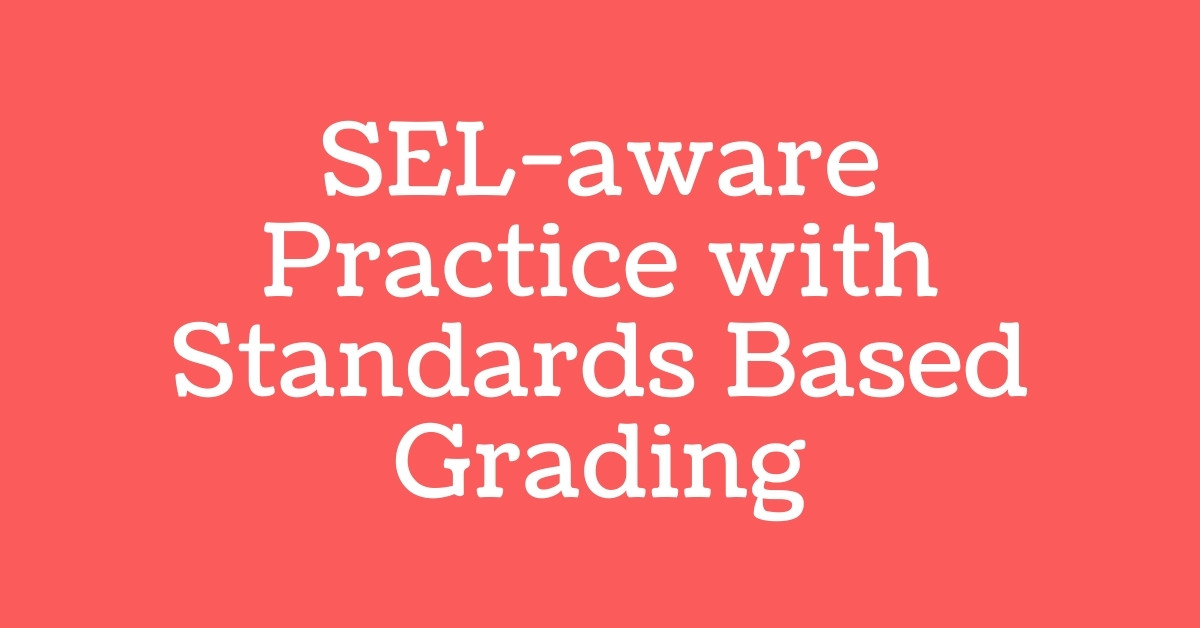Whether we want to admit it or not, grading is a powerful influencer on emotional wellness. The letter or number on top of an assignment communicates more than performance; to many students, the grade on an assignment communicates value.
Grading can be a double-edged sword. When students struggle in a class, low grades reinforce existing negative self-perception. When students do well in a class, low grades harm confidence. The only way to break out of this cycle is to reframe what grades communicate. Standards-based grading (SBG) is a system which allows us to proactively change our grading to promote positive academic and emotional mindsets in students.
What do grades communicate?
In an ideal world, a grade would communicate a student’s understanding of the material. In reality, this ideal is hard to reach. Do a quick self check. Have you ever…
- deducted points for being late?
- refused to take late submissions?
- deducted points for not having a name or date?
- deducted points for “sloppy work?”
If you answered yes to any of those questions, then your grades have been influenced by something other than what a student knows and can do. The reality is that our grades are a combination of many factors. The good news is that we can work to remove those outside factors and get to a point where it truly represents what a student knows.
Reframing grades
SBG provides an instructional framework which ties assignments to essential standards. As teachers, we do this implicitly. We know what a given assignment means in the big picture. Here’s the problem: students don’t see that connection. They’re missing the big picture, so a grade turns into a value statement: the work they did on an assignment was valuable (high score) or not (low score).
Here are some ways you can reframe grades in your classroom.
Make the implicit explicit
Try this: for an upcoming assignment, make an explicit statement about which skill you’re looking for evidence on. Student completion of that thing now becomes evidence of learning. Remind them that evidence is how you know what they know and what they still need help in achieving.
Our language of learning with students has to include demonstration of knowledge. This starts the process of removing grades from students’ perceptions of self-worth and value in your class. We’re putting the focus on the demonstration at this moment. You can (and probably) should even make it clear that this is an attempt today and not a final evaluation. We are looking at this evidence so you can enter the feedback cycle.
Using evidence for feedback
John Hattie’s professional practices index is a good reference when evaluating instructional impact. He and his team evaluated more than 250 instructional practices and assigned each a score against student performance. According to his study, a score of 0.4 or greater on a given practice represents a potential net positive impact.
Statistically, feedback (0.66), clear goal intentions (0.51), and teacher clarity (0.74) all have a high probability of accelerating student learning. Defining the learning goal (or the skill goal) ahead of the assignment frames the work for the student appropriately. It is clear that any judgement is on the evidence and not a value statement on the student themselves.
After you gather evidence, it is time for clear, actionable, and timely feedback. Feedback is a two way street: students show us what they know based on evidence (feedback on our teaching up until that point) and we provide feedback on strengths and weaknesses. Explicit targets and feedback are mutually supportive: we cannot give powerful feedback if there is no clear target specified and we cannot have growth toward those targets without feedback.
What about responsibility?
SEL can be incorporated into every single lesson. Student competencies for developing a well-balanced mindset can be supported by setting clear learning and performance expectations in our classrooms. A push against SBG is that students have a free-for-all when completing work, which is a myth. Interestingly, self efficacy is a powerful statistical indicator of student growth according to Hattie’s research (0.71). This means we need to continue to set achievable goals and benchmarks for students to work toward. These are not final attempt deadlines, but points in time they can use as a litmus test for making adequate progress.
Feedback can – and should – extend to student work habits and self-regulatory behaviors. According to instructional expert, Geoff Petty on The Teacher’s Toolbox,
As well as feedback on the task Hattie believes that students can get feedback on the processes they have used to complete the task, and on their ability to self-regulate their own learning. All these have the capacity to increase achievement.
This comes with a warning. Petty continues, “Feedback on the ‘self’ such as ‘well done you are good at this’ is not helpful. The feedback must be informative rather than evaluative.” Students need clear, actionable information about their evidence in order to make progress. This extends to their process – was the work on time, was it complete, etc – as well as the content.
Put the lipstick away
Are we just sugar coating the fact that some students do poorly in some courses?
No.
Standards-based grading is not removing the responsibility of learning from the student. It is reframing how we communicate learning by focusing on the skills and objectives while at the same time removing non-academic influences on a student grade. The goal is to help a student understand – at any given point – what they can do now and what they still need to work on.
Students may still struggle in class. The main difference is that they have a clear signal about which ideas they struggle with instead of feeling like a failure on the whole. Additionally, you now have a clearer picture of which specific concepts students need more support in and you can make those interventions more strategically.
The SEL Aware Classroom
SEL awareness is more than knowing that students learn social-emotional cues and responses through their school experiences. It means we are tailoring our classrooms to grow students as scholars as well as responsible, regulated members of the community. Our teaching practices influence that significantly.
Grading, on the whole, is one of the most influential aspects of school. Ask your students how their grades affect their self-perception. What practices can you change in order to provide a net positive rather than a net negative impact on student learning?
The blog, From Experience to Meaning… had a helpful graphic with all 256 factors analyzed by John Hattie. The PDF was enormous, so we shrunk it down into something more manageable here.



